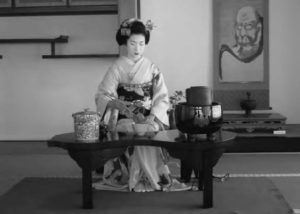Mindfulness has become trendy around the world in recent years— but in Japan, it’s been ingrained into the culture for centuries.
—BBC Travel
Contemporary society is beset with physical and digital noise. News media supply a never-ending stream of sensational stories. Cellphones, computers, and video games distract teen and adults constantly, and almost unlimited access to one another through social media sites only increases tensions between and among individuals. It is almost impossible to quell the noise, and the effects of it are detrimental to individuals and societies.
In 2015, CNN conducted a study with researchers at the University of California at Davis and the University of Texas at Dallas to analyze the use of social media among thirteen-year-old students. The researchers determined that “there is no firm line between their real and online worlds.”1 Moreover, students’ parents are not immune to the effects of technology, as many adopt their children’s digital habits and fall prey to the same tensions and anxieties that teens do. Families are talking less and texting more. People use technology, especially cellphones, to maintain distances between them and others. Digital hyperconnections undermine interpersonal relationships, and, ironically, through these connections, people have become more personally isolated. One result of this hyperconnectedness is an alarming increase in the number of young people and adults who suffer from depression and anxiety.
To combat this situation, many schools have begun to include “mindfulness training” in the classroom, either as distinct instructional units or as specific classroom practices. Since some parents view such instruction as “teaching religion,” some schools have abandoned their “mindfulness” approach, either discontinuing established programs or refusing to implement them. Fortunately, however, teaching about traditional Japanese culture allows schools to avoid such concerns, as mindfulness practices and techniques can be incorporated into instructional units without any connection to “religious instruction.” By introducing students to haiku, the tea ceremony, and Zen gardening, teachers can expose students to Japanese history and teach about Buddhism by infusing mindfulness instruction into lessons focused on Japanese literature and traditions. It is important to reiterate to students that although learning techniques to foster mindfulness can be taught as part of understanding Zen Buddhism, similar techniques also have a rich heritage in contemplative Christianity dating back to the early followers of the faith. Also, many Japanese who don’t practice Buddhism or aren’t even Buddhists learned mindfulness techniques that are, in a secular sense, virtually embedded in Japanese culture. Additionally, such topics lend themselves to interdisciplinary studies, and classroom instruction is easily differentiated based on the ages and readiness levels of the students. In fact, these concepts and topics can be delivered to students on all grade levels, with age-appropriate modifications. A list of suggested teaching resources appears at the end of the paper.
Haiku

As soon as students understand the concept of “syllable” and can count, they can begin to compose haiku. That this type of poem has a regular form makes it more accessible to budding writers. More importantly, though, the tradition of haiku includes attention to the present while going beyond it. As Thomas Hills explains in Psychology Today, “A good haiku captures something that transcends the moment, but which at the same time can only be expressed ‘in the moment.’ It is both inside and outside the mind of the author and the reader.”2 Writing haiku appeals to students because of its length (three lines, seventeen syllables), and teachers generally find it easy to teach. Notably, although the form is revered in Japan and has become popular throughout the world, there are only a few well-known haiku masters: Bashō, Issa, Buson, and Shiki. To introduce this form of poetry to students, then, teachers can direct them to locate information on the history of haiku and the works of Bashō, Issa, Buson, and Shiki.
After students complete their research, they can write haiku of their own. In connecting mindfulness and haiku, the teacher might direct students to focus on the writing process as it occurs so that students can connect to their feelings and their environments. Their oral and/or written reflections can address questions such as these:
• What were you thinking while you were writing your haiku?
• How did you feel when you completed your poem?
• How did you feel when you read your poem aloud?
• What did you want your classmates to get out of your poem?
As a closing activity, students write their haiku on cardstock and illustrate their poems. These can be displayed on the classroom walls for a week or so and then bound into a book to be kept in the room for reference throughout the remainder of the school year. More importantly, it can serve as a reminder of the beauty of quietness and reflection.
Tea Ceremony

The image of a Japanese woman dressed in a kimono kneeling on a mat and pouring tea is one that most people know. In fact, such a scene is among the first to come to mind when someone mentions Japanese culture. Hot green tea, silk kimonos, and tatami mats seem distinctly Japanese, although the tea ceremony is not unique to Japan—China and Korea have their own versions of this rite. Yet the formality and quietness of this ceremonial event reflect the traditional culture of Japan well and serve to introduce Western students to its traditions.
The Japanese tea ceremony is rooted in Zen Buddhism, and its use of ritual supports mindful behavior. For many students, the careful and deliberate attention to details throughout this formal procedure may pose challenges initially: there is nothing rushed or random in the tea ceremony. Before the tea is served to guests, the host carefully prepares for all aspects of the event: selecting and arranging the flowers, setting the table, seating the guests, and brewing and serving the tea. The process has been precisely followed for centuries, and what today’s students experience should be similar to the purposes of a traditional Japanese tea ceremony: the cultivation of a feeling of respect for and connection to the other guests and an appreciation of the present. According to Zen Buddhism, the universe can be wholly experienced by drinking a single bowl of tea, since the participant surrenders himself or herself to the present and shares tea with an unselfish, caring spirit. For students, the methodical preparation of the tea reveals the importance of attention to details and the significance of being “present in the present,” fostering mindful behavior.
Holding a tea ceremony in the classroom is appropriate for students on all grade levels, although the pacing of the experience should be adjusted to accommodate students’ attention spans and maturity levels. As students are introduced to a traditional Japanese ceremony, they are encouraged to act purposefully and focus on the present. They participate in a quiet event that fosters a sense of strong connection to others and allows them to act mindfully while learning about Japanese history and culture. At the close of the tea ceremony lesson, students can participate in some type of reflection orally, in writing, or artistically to reinforce what they learned
from their experiences.
Zen Gardening

Like the tea ceremony, Zen gardening is rooted in Japanese culture and the Buddhist tradition. The purposes of this exercise are to evoke feelings of tranquility and peace, and foster a strong sense of connection to nature and other people. Rocks and sand or gravel are used to represent the essence of nature, and the swirling lines have a calming effect on the mind. As students learn about Zen gardening, they can create their own in shoeboxes or other small containers. Once they finish their gardens, they can share them with their classmates and reflect on how they felt and what they learned in the process. Throughout the school year, students will be able to look at their gardens and, if they need to relieve stress, rake the sand or gravel and experience a sense of tranquility again.
Conclusion
Learning about other cultures helps students of all ages. As they explore the traditions of other countries, they grow intellectually, emotionally, and socially. Moreover, they benefit personally from participation in activities that foster tolerance, patience, and calmness. Such is the goal of using lessons rooted in the Japanese traditions of haiku, the tea ceremony, and Zen gardening to support mindfulness in the classroom. These lessons also address nationwide educational standards in English/language arts, world history, and the arts. Additionally, they accommodate the different learning modalities of the students and allow for differentiated instruction. Kinesthetic learners will enjoy the hands-on nature of creating small gardens, illustrating haiku, and participating in the tea ceremony. Visual learners will respond to the aesthetics of the gardens, the balanced staging of the tea ceremony, and the arrangement of the syllables and lines in their haikus. Auditory learners will appreciate the class discussions related to each topic, the power of the short poems being read aloud, and the quiet sounds associated with the tea ceremony. Regardless of their individual learning styles, as students participate in activities
that require them to focus on the present and work deliberately, they become more connected to the world around them. They also learn how to cope more effectively with stress and noise as they find tranquility within their frantic, hyperconnected digital worlds and discover within themselves the strength required to address difficult situations. This may prove to be one of the most meaningful and profound learning outcomes that students realize in their school careers. ■
NOTES
1. Schrobsdorff, Susanna. “Teen Depression and Anxiety: Why the Kids Are Not Alright.”
Time, Time, October, 27, 2016, https://tinyurl.com/kfqa8d3.
2. Hills, Thomas. “Waiting for the Haiku in Mindfulness.” Psychology Today, Sussex
Publishers, https://tinyurl.com/ycl2ssn9.
RECOMMENDED RESOURCES
“Benefits of Mindfulness: Practices for Improving Emotional and Physical Well Being.”
Depression in Older Adults: Recognizing the Signs of Elderly Depression and Getting
Treatment. Accessed December 10, 2018. https://tinyurl.com/kvg42jq.
Davenport, Mary. “Mindfulness in High School.” Edutopia. George Lucas Educational
Foundation. February 1, 2018. https://tinyurl.com/y8y46seu.
Davis, Lauren Cassani. “When Mindfullness Meets the Classroom.” The Atlantic. August
31, 2015. https://tinyurl.com/oj9p2yy.
“Experiencing Haiku through Mindfulness, Movement & Music.” ReadWriteThink.
https://tinyurl.com/ngtuxgo.
Saybrook University. “Mindfulness: Can We Learn from the US about Adopting Asian
Cultures?” July 17, 2018. https://tinyurl.com/yaam5nps.
Monk Helps Stressed Welsh Students; Meditation Guides Children through Exam Pressures.
Western Mail. Cardiff: Wales, June 25, 2003.
Pannoni, Alexandra. “Teachers: Use Mindfulness to Help Students’ Academics.” US News
& World Report. January 1, 2018. https://tinyurl.com/y8gh5nrr.
Powell, Steve John. “The Japanese Skill Copied by the World.” BBC Travel. May 9, 2017.
https://tinyurl.com/lv4neke.
Stevens, Alison Pearce. “‘Mindfulness’ Defuses Stress in Classrooms and Teaching.” Science
News for Students. July 3, 2016. https://tinyurl.com/y8ke8o98.
For background information/basic research, see: Asia for Educators (AFE), http://afe.
easia.columbia.edu/; Education About Asia (EAA), https://www.asian-studies.org/Publications/
EAA/About; National Consortium for Teaching about Asia (NCTA), http://
www.nctasia.org/; and Stanford Program on International and Cross-Cultural Education
(SPICE), https://spice.fsi.stanford.edu/.
GENERAL TEACHING RESOURCES
Anesaki, Masaharu. Art, Life, and Nature in Japan. Boston: Marshall Jones Company, 1933.
Burleson, Patricia. “The History and Artistry of Haiku.” Stanford Program on International
and Cross-Cultural Education (SPICE). October, 1998. https://tinyurl.com/ya7oe2ku.
Gillis, Anna Maria. “Destination Japan.” Humanities 28, no. 2 (2007): 18+.
Goral, Tim. “Schools are Teaching, not Preaching: Studying World Religions Can Foster
Tolerance, but Public Schools Must Also Respect Students’ Rights.” District Administration
53, no. 11 (2017): 39+.
“History of the Japanese Tea Ceremony.” The Japanese Tea Ceremony. http://japanese-
tea-ceremony.net/history.html.
“Learn the History of the Japanese Zen Garden.” Times Square Chronicles. March 10,
2018. https://tinyurl.com/yamn5pu8.
Levine, Gregory P. “Critical Zen Art History.” Journal of Art Historiography 15 (2016): 1+.
Lidke, Jeffrey S. “A Review of Asian Texts, Asian Contexts: Encounters with Asian Philosophies
and Religions, David Jones & E.R. Klein, eds.,” Southeast Review of Asian Studies
33 (2011): 255–257.
Miller, Lisa. “Belief Watch: Budding Buddhists.” Newsweek, June 10, 2007.
Miller, Mara. “Japanese Gardens as Texts and Contexts.” East-West Connections 7, no. 1
(2008): 85–106.
Neuman, Matthias. “Revisiting Zen and the Birds of Appetite after Twenty-Five Years.”
The Merton Annual 8, (1995): 138–149. The Thomas Merton Center at Bellarmine University.
https://tinyurl.com/ybednuvy.
“Online Museum Resources on Asian Art.” Asia for Educators. https://tinyurl.com/5egn7g.
“Religions—Buddhism: Zen Buddhism.” BBC. October 2, 2002. https://tinyurl.com/4bnkdub.
Rohr, Fr. Richard. “Contemplative Christianity Is the Great Tradition.” Center for Action
and Contemplation. January 20, 2017. https://tinyurl.com/ycjasynu.
Stevens, Peggi R. “Everything Japanese.” School Arts 103, no. 7 (2004): 44+.
Walkup, Nancy. “The Nature of Art and Art About Nature.” School Arts 104, no. 2
(2004): 34.
HAIKU
“Aim for the Heart: Using Haiku to Identify Theme – ReadWriteThink.” Readwritethink.
org, https://tinyurl.com/mp3zcuc.
“Haiku Society of America Educational Resources.” Haiku Society of America, www.
hsa-haiku.org/education.htm.
“Haiku: Teaching Japanese Poetry Writing | Education World.” Creating a Safe Classroom
Environment | Education World, https://tinyurl.com/23ls56d.
Larrabee, Hart. Haiku: Classic Japanese Short Poems (Chinese Binding). Edison, NJ:
Chartwell Books, 2016.
“Let’s Do Haiku!” Education for Today and Tomorrow | L’Education Aujourd’hui Et Demain,
www.teachmag.com/archives/7894.
Waidyatilleka, Cate. “Writing a Haiku.” YouTube, https://tinyurl.com/ya6nl9mx.
TEA CEREMONY
Barry, Jeff. “The Japanese Tea Ceremony” (collection of links to online resources).
https://libguides.wlu.edu/japaneseteaceremony.
Hall, Stephanie. “Teaching the Japanese Tea Ceremony: Mine Somi Kubose.” Library of
Congress. May 10, 2017. https://tinyurl.com/yard7rqd.
“Japanese Tea Ceremony.” Five College Consortium. www.fivecolleges.edu/tea_ceremony.
Landeck, Melinda. “What Is Teachable About Japanese Tea Practice?” Education About
Asia 18, no. 1 (2013): 48–50. https://tinyurl.com/ybmvb646.
Macaulay, Sara Grove. “Japanese Tea Bowls: A Historical Look and a Class Project. (Integrating
the Curriculum).” Arts & Activities. February 2003: 34+.
“Tea Traditions.” Teach Japan: Resources for Students and Educators. https://tinyurl.com/
yd4s8pyc.
Varley, Paul. “The Evolution of the Tea Ceremony.” About Japan: A Teacher’s Resource.
2018. https://tinyurl.com/ya3wxhgd.
Yamamoto, Kohei. “Procedure of Tea Ceremony.” YouTube. https://tinyurl.com/ybnlaqww.
ZEN GARDENING
Bonsai, Masteryo. “Basics of the Zen Garden.” YouTube. https://tinyurl.com/y7o89yuc.
Cunningham, Eric. “Cultivating Enlightenment: The Manifold Meaning of Japanese Zen
Gardens.” Education About Asia 21, no. 3 (2016): 32–36. https://tinyurl.com/y92oxr7m.
Kemp, Sid. “The Beauty and Meaning of Zen Gardens.” Dengarden. October 24, 2016.
https://tinyurl.com/y9yoa7mz.
Paramapoonya, Om. “Zen Rock Garden—History, Philosophy and How-To Guide.” Dengarden.
April 5, 2016. https://tinyurl.com/y99wl3kt.
Verma, Gujan. “Why Do You Need a Zen Garden?” Times of India. August 24, 2016.
https://tinyurl.com/z6vvx4h.
“Zen Garden.” Free Games for Kids. https://tinyurl.com/ybqkja5x.

